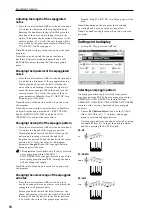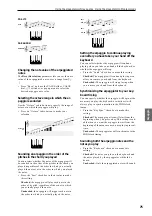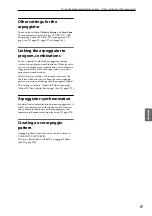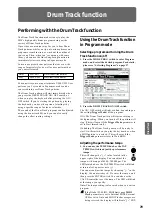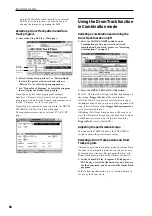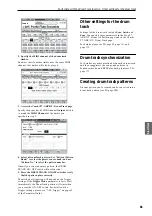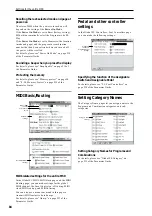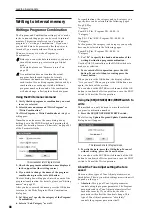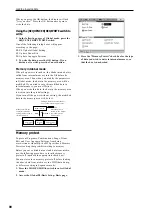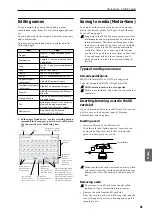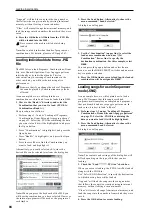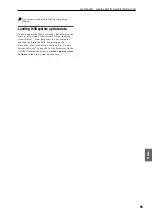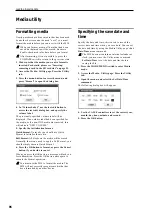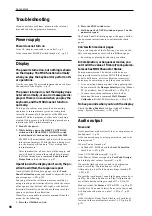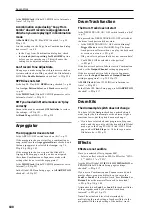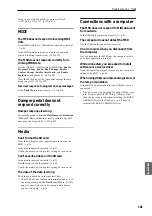
Program
Combination
Sequencer
Effect
Arpeggio
Drum Track
Global
Media
87
Loading & saving data
Saving data
Types of data that can be
saved
You can save the various types of data in the M50 by
writing it to internal memory, by saving it to an SD
card (commercially available), or by sending it as a
MIDI data dump.
Writing to internal memory
The following types of data can be written into the
internal memory.
• Program
Programs 000–127 in banks A–E
• Combination
Combinations 000–127 in banks A–D
• Global settings
(Global P0: Basic Setup–P4: Category)
• User drum kits
00(INT)–47(USER)
• User arpeggio patterns
U0000(INT)–U1027(USER)
• User Drum Track patterns
U000–U999
(See page 79)
• User template songs U00–U15
Song settings such as the song name and tempo,
track settings (see PG page 126), arpeggiator, and
effect settings can be saved (written) to internal
memory. However, the musical data for song tracks
and patterns are not saved to internal memory.
Furthermore, settings that govern how the musical
data is played back such as Meter, Metronome,
PLAY/MUTE
, Track Play Loop (including Start/
End measure), and RPPR settings will not be saved
either. Use the Sequencer mode menu command
Save Template Song
to write this data; for details,
please see “Save Template Song (Save as User
Template Song)” on page 192 of the Parameter
Guide.
• Effect presets
For each effect, you can write parameter settings
into internal memory by using the menu command
Write FX Preset
.
Data that you edit in Sequencer mode can only be
saved to media; it cannot be saved in internal
memory.
About preloaded data and preset data
“Preloaded data” refers to the data that is loaded in the
M50 when it is shipped from the factory. You are free to
rewrite this data, and with the exception of the demo
songs, the data will be written to the location as
described in “Writing to internal memory.” This data is
stored in the M50’s system area.
You can reload the factory preload data into internal
memory by using the Global mode menu command
Load Preload/Demo Data
.
Preset data, on the other hand, is data that cannot be
overwritten by the Write operation. This includes the
following data.
• GM program banks GM, g(1)–g(9), g(d)
• GM drum kits 144(GM)–152(GM)
• Preset template songs P00–P15
• Preset patterns P000–P671
Saving to media
The following data can be saved to various types of
media.
• .PCG file:
Programs, Combinations, Drum kits, Global
settings, user Drum Track patterns, and user
arpeggio patterns (The data that was checked in the
check boxes of the Save dialog box will be saved.)
• .SNG file:
Song and cue list.
• .EXL file:
System exclusive data from an external device that
was saved on the M50 (This allows the M50 to be
used as a data filer.)
• .MID file:
Saves a Sequencer mode song in Standard MIDI
File (SMF) format.
MIDI data dump
The M50 can transmit the following types of data as a
MIDI data dump; you can save this data on an external
data filer or other device.
• Programs, combinations, drum kits, and global
settings
• Song and cue list
• User drum kit patterns
• User arpeggio pattern
For details, please see “Dump:” on page 253 of the
Parameter Guide.
Summary of Contents for EASYSTART M50
Page 1: ...3 E Owner s Manual ...
Page 84: ...Arpeggiator function 78 ...
Page 88: ...Drum Track function 82 ...


